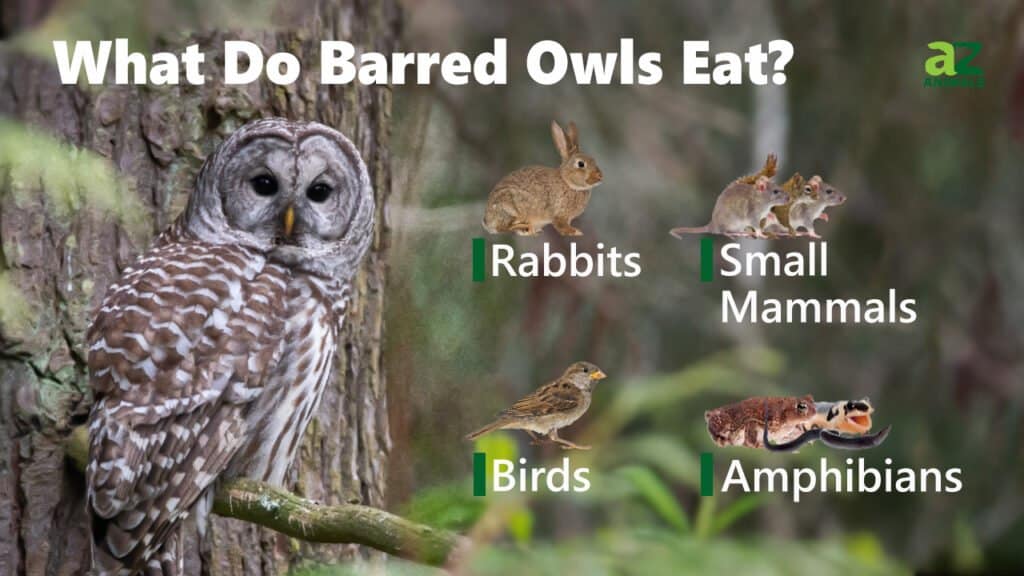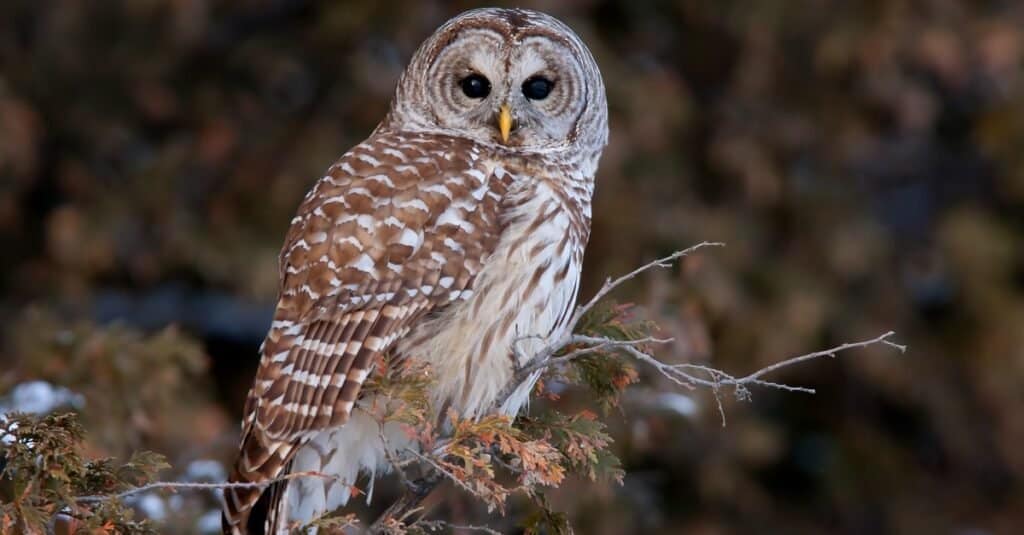Barred owls live across most of the United States east of the Mississippi, across much of Canada, and into the Pacific Northwest. These birds are non-migratory and tend to stick to small areas, so if you have a barred owl nearby, odds are you’ll be seeing it for a while! Let’s discover more about these incredible owls, and take a look at everything from what barred owls eat to what eats them!
What Foods Do Barred Owls Eat?

A barred owl eats small mammals, fish, insects, small invertebrates, amphibians, and reptiles. They are an opportunistic predator.
Barred owls are carnivores, and their prey must be small because this owl likes to eat its prey whole. This behavior is just like most other owls.
Here is a list of foods that barred owls eat:
The Barred Owl’s Diet

Barred owls are expert hunters that can even catch bats in flight.
©Lynn_Bystrom/Shutterstock.com
Barred owls are opportunistic, and they’ll eat just about any meat source that they can kill with their talons.
The mammals barred owls eat are rabbits, mice, voles, bats, shrews, opossums, etc. Barred owls eat mice because they’re easy to pounce on from above, and rodents of all types are their primary food source. In the winter, they rely almost solely on rodents.
Amazingly, barred owls are such expert hunters they can catch bats in flight, despite their quick darting and dashing movement. Their stealth and gliding approach can win out over their nimble prey. For the most part, nothing is off the table for barred owls’ dinner menu. They’re also known to eat very young kittens, so let’s all be sure to keep a watchful eye out for our smaller pets if you are in owl territory!
Barred owls eat small birds like house sparrows, grouse, and wrens, as well as salamanders, insects, turtles, frogs, snakes, chickens, and fish. They particularly like cliff swallows which are one of the few birds they actively hunt instead of taking when the opportunity arises.
They’ll go after bird’s nests for eggs and chicks. Barred owls consume crawfish by going into shallow water in search of them. Some of them eat so many crawfish that they turn pink on their undersides for the exact same reason flamingoes are pink. Barred owls will wade into the water to eat fish when they are plentiful as well.
Because they swallow their prey whole, they end up regurgitating things that can’t be digested like teeth, parts of insects, and fur. Most bones are digested for the needed nutrients in them, like phosphorus and calcium. Prey that they can’t swallow whole is ripped into pieces with the head being consumed first. Because they eat food this way, they don’t have teeth (similar to all birds).
How Do Barred Owls Hunt for Their Food?
Barred owls hunt for food using their asymmetrical ears, sharp talons, powerful beaks, and big eyes that allow them to see at night. Their ear placement allows them to hear the exact direction that prey is coming from, and their heads turn 270 degrees so their big eyes can scan the ground. The feathers around their faces help funnel sounds into their ears so they can hear even the slightest disturbances.
They sit up in the tops of trees, scanning the ground, and use their swift flying speed to scoop up prey. They’ll hop from perch to perch until they detect something that they want to try and catch. They’re one of the most dangerous owls in North America because they’re so good at hunting.
How Do Baby Barred Owls Eat?
Barred owls are also responsible for hunting for food for their chicks until they’re old enough to leave the nest. They do this with their mate for about 6 months. Barred owls mate for life, and both hunt for food for their brood. The female barred owl is the only owl that will tear food up for the chicks, though, so the father generally does the hunting while mom does the feeding.
Adult barred owls sometimes drink water, but baby barred owls solely get their water from prey.
What Eats Barred Owls: What Predators Do Barred Owls Have?

Barred owls are effective predators, but are sometimes eaten by larger great horned owls.
©Jim Cumming/Shutterstock.com
The great horned owl is a natural predator of the barred owl because it is bigger than the barred owl. They also compete for territory. Great horned owls will even eat adult barred owls as well as their chicks. It’s such an enemy of the barred owl that they generally don’t go out into open clearings to avoid birds of prey. Northern goshawks are also a predator of the barred owl.
Since barred owls tend to live in suburbs, they sometimes accidentally die in traps meant for other animals. Barred owls are also at risk of getting hit by cars since they feed on roadkill. They are also prey for raccoons and weasels. Usually, a barred owl is preyed upon when it is still a baby. Their eggs are generally a couple of inches long which is the perfect snack for a wide array of animals.
Smaller birds like woodpeckers and songbirds will occasionally gang up on barred owl families because they know they are a predator. This often results in the death of at least a few birds.
Even though they have predators, they are one of the “least concern” animals regarding endangerment. In fact, they’re so proliferous that they’ve invaded the northern spotted owl’s territory on the west coast. Scientists are considering whether they should kill the barred owl population in the area to save the northern spotted owls.
Where Do Barred Owls Live?
Barred owls primarily live and hunt in human suburbs because people draw the barred owl’s prey into their neighborhoods. You’ll most likely find them in parks with big trees. They like a wide variety of trees such as western larch, white spruce, balsam poplar, aspen, oak, maple, and hickory trees. They tend to nest in the forest and use snags and tree hollows most often as their nesting spot.
They can also be found in the forests of southeastern Canada, the Pacific Northwest, the eastern USA, and along the west coast of Mexico. They don’t migrate unless shelter or food is too limited. They are generally found in mature trees, swamps, and any kind of woodland.
Some Final Barred Owl Facts
Barred owls reach their 30s in captivity, but in the wild, they live for about a decade. Barred owls are also known as ol’ eight-hooters, hoot owls, northern barred owls, and striped owls. That’s because they have a distinctive and loud hoot they use to defend their year-round territory. It’s illegal to own one as a pet.
Their scientific name is Strix varia, which is Latin for a baby-eating vampiric owl monster, so it’s no surprise that they’re carnivorous and eat small prey.
Up Next:
- Owl Predators: What Eats Owls? So we know owls are fierce predators, but read to find out what comes after them!
- Why Do Owls Hoot at Night? Whether you find it slightly eerie or kind of cute, the owl’s hoot is one of the most recognizable sounds in the animal kingdom. But why do they do it?
- Are Owls Raptors? What makes a raptor a raptor? And does this night stalker make the list?
The photo featured at the top of this post is © iStock.com/Harry Collins
Thank you for reading! Have some feedback for us? Contact the AZ Animals editorial team.






